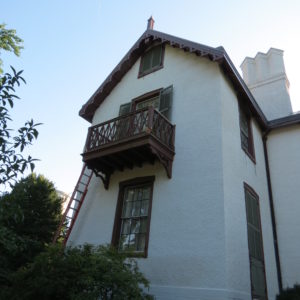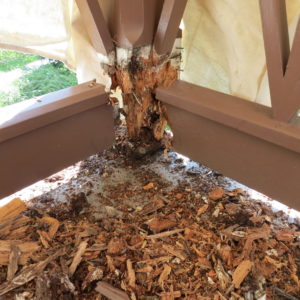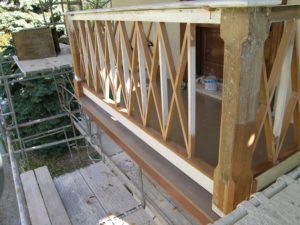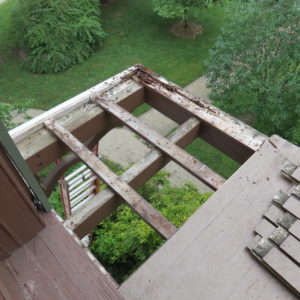For this month’s preservation update, Senior Preservationist Jeff Larry explains how we’re currently restoring a balcony on the Cottage’s western elevation. The balcony is inspected twice yearly and was lasted prepped and repainted in 2014. Upon its most recent inspection, water damage was detected.
It seems appropriate that I am writing this month’s post from Buffalo, New York where I am attending the Association for Preservation Technology’s (APT) annual conference. APT is the preeminent organization dedicated to promoting the best technology for conserving/preserving historic structures.
The Cottage has three balconies each with their own unique design and preservation challenges. There is however one common challenge and that is to monitor and manage the effects of moisture intrusion particularly when the deleterious effects of the moisture go unseen until significant damage has occurred. Such was the case recently when an inspection of the west balcony revealed that moisture-related deterioration to the base of both posts was not limited to the surface but rather the entire base, all of the floor boards, and sections of the upper rail and trim.
Before developing a restoration plan it was important to understand the cause of the damage. That process started with a review of the work completed on the balcony over fourteen years ago. The west balcony was reconstructed in 2004 as part of the capital campaign to restore the Cottage to its Lincoln-era appearance and only the posts and upper rail are original.
During the restoration, the posts were attached directly to the floor boards. This proved to be the most significant cause of deterioration to the posts. Without an air space between the post and the flooring, moisture was trapped and subsequently allowed to wick up through the exposed end grain of the post. Moisture also found its way through the tongue and groove joinery of the floor boards and beneath the rail cap and skirt board.
To fully assess the damage and begin the restoration, the entire balustrade (with posts), all of the flooring, and trim work were carefully removed.
Fortunately, there was no significant damage to the framing. The balcony is stabilized and over the next two weeks I’ll be putting together a restoration plan that will address the aforementioned design flaws. For now I’m focusing on the next Conference session “Specifying Wood: Reconciling History, Changing Ecosystems, and the Lumber Industry”!




